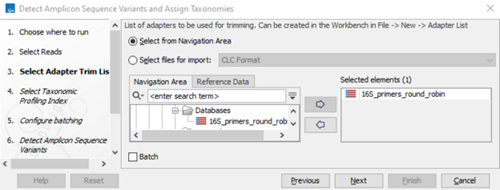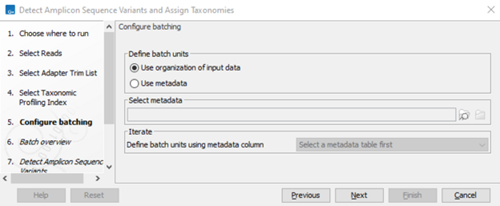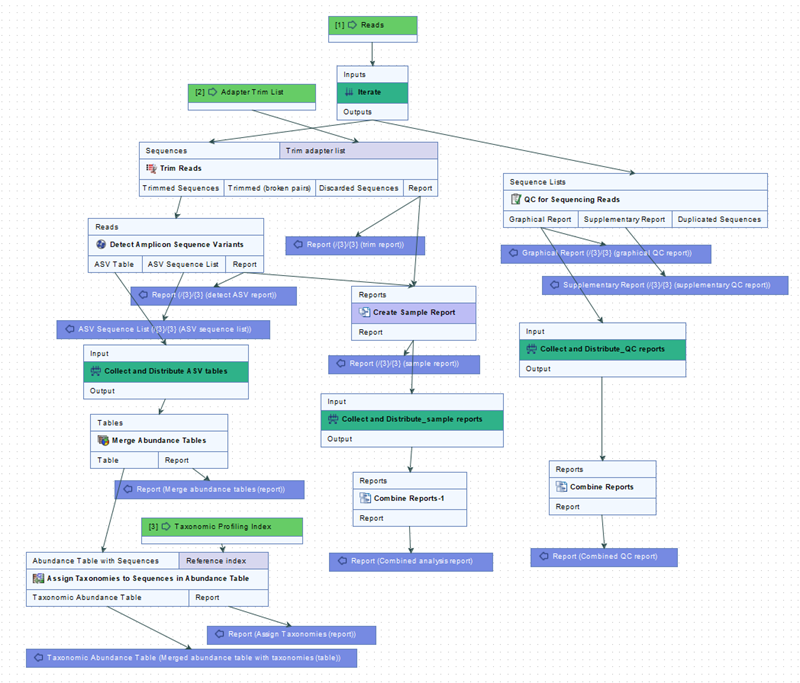Detect Amplicon Sequence Variants and Assign Taxonomies
The Detect Amplicon Sequence Variants and Assign Taxonomies workflow processes reads from amplicon sequencing to yield a merged multi-sample (if applicable) ASV abundance table, and subsequently assigns taxonomies to the ASVs (amplicon sequence variants).
We recommend making preliminary evaluations of the read lengths and qualities, to decide on parameter settings like read length. This can be done by running a single sample through the workflow, and taking a look at the resulting trim report section Read length before / after trimming.
The workflow requires a Trim Adapter List to remove adapters from the reads and a Taxonomic Profiling Index to assign taxonomies to ASVs. If the reads have already had adapters removed, we recommend creating a copy of the workflow (right-click the workflow in the Toolbox and select 'Open Copy of Workflow'), removing the Adapter Trim List input, and saving the modified workflow. When running the modified workflow, the Adapter Trim List can be left out to skip adapter trimming, but 'Quality trimming' and 'Automatic read-through adapter trimming' will still take place.
Launching the workflow
The Detect Amplicon Sequence Variants and Assign Taxonomies workflow is at:
Toolbox | Template Workflows (![]() ) | Microbial Workflows (
) | Microbial Workflows (![]() ) | Metagenomics (
) | Metagenomics (![]() ) | Amplicon-Based Analysis (
) | Amplicon-Based Analysis (![]() ) | Detect Amplicon Sequence Variants and Assign Taxonomies (
) | Detect Amplicon Sequence Variants and Assign Taxonomies (![]() )
)
Launch the workflow and step through the wizard.
- Select the sequence list(s) containing the reads to process and click on Next.
- Select a Trim Adapter List corresponding to the adapters used for sequencing and click on Next (figure 3.27).
- Select a Taxonomic Profiling Index and click on Next (figure 3.28).
- The 'Configure batching' and 'Batch overview' steps can be left as is (figure 3.29), or configured as described in http://resources.qiagenbioinformatics.com/manuals/clcgenomicsworkbench/current/index.php?manual=Launching_workflows_individually_in_batches.html.
- Choose the trim length to use for your reads and decide whether to remove chimeras by toggling the 'Remove chimeras' box. Click on Next (figure 3.30).
The optimal read length setting will depend on the length of your reads after trimming. We recommend that you have a look at the trim report section Read length before / after trimming if you are unsure about what value to set.
- Finally, select a location to save outputs to and click on Finish.

Figure 3.27: Wizard step for selecting the Trim Adapter List.

Figure 3.28: Wizard step for selecting the Taxonomic Profiling Index.

Figure 3.29: Optional wizard step to configure metadata for the input sequences.

Figure 3.30: Wizard step for selecting read trim length and whether to remove chimeras in the Detect Amplicon Sequence Variants tool.
Tools in the workflow and outputs generated
The Detect Amplicon Sequence Variants and Assign Taxonomies workflow consists of the below mentioned tools. See figure 3.31 for a full overview of the workflow.
- QC for Sequencing Reads performs basic QC on the sequencing reads and outputs a report that can be used to evaluate the quality of the sequencing reads. See http://resources.qiagenbioinformatics.com/manuals/clcgenomicsworkbench/current/index.php?manual=QC_Sequencing_Reads.html. Here, a graphical and a supplementary report is output for each input sample.
- Trim Reads removes adapter sequences and low quality nucleotides. See http://resources.qiagenbioinformatics.com/manuals/clcgenomicsworkbench/current/index.php?manual=Trim_Reads.html. The tool outputs a trim report for each sample.
- Detect Amplicon Sequence Variants trims and filters the reads, followed by dereplication and denoising. If chosen in the wizard, chimeras will be removed, and in case of paired-end reads, the unique read pairs are merged, see Detect Amplicon Sequence Variants). The workflow outputs one ASV sequence list and ASV report per sample.
- Merge Abundance Tables merges the per-sample ASV abundance tables from the previous step and outputs a merge report. The merged ASV table is used as input for Assign Taxonomies to Sequences in Abundance Table.
- Assign Taxonomies to Sequences in Abundance Table takes the merged ASV abundance table and assigns taxonomies to the sequences according to the reference index provided (see Assign Taxonomies to Sequences in Abundance Tables). The tool outputs a report and a merged ASV abundance table with taxonomies.
To learn about the ASV abundance table, see Detect Amplicon Sequence Variants output.
- Combined analysis report combines the report content from the Trim Reads and Detect Amplicon Sequence Variants tools for all samples in the workflow run.
- Combined QC report contains QC metrics for the raw reads for all samples in the workflow run.

Figure 3.31: Layout of the Detect Amplicon Sequence Variant and Assign Taxonomies workflow.
